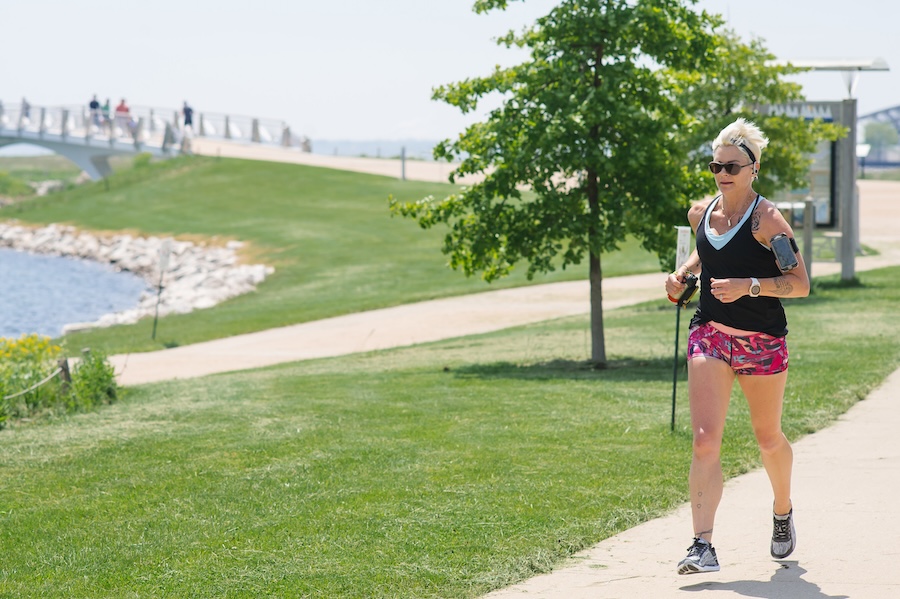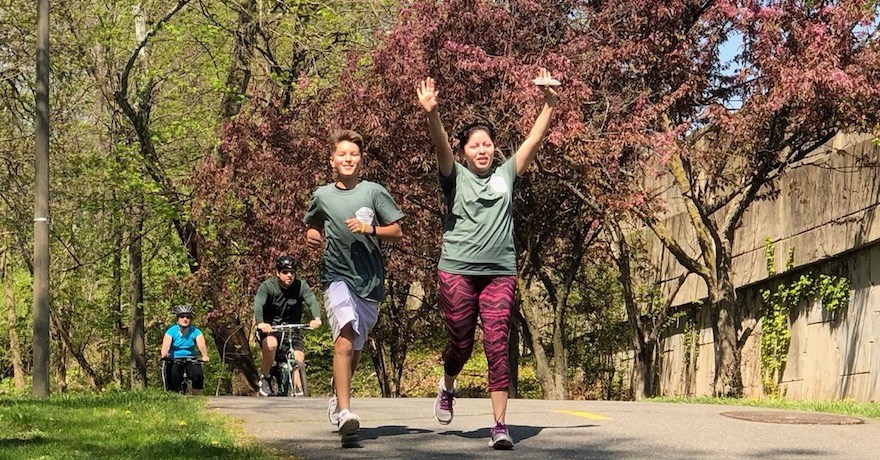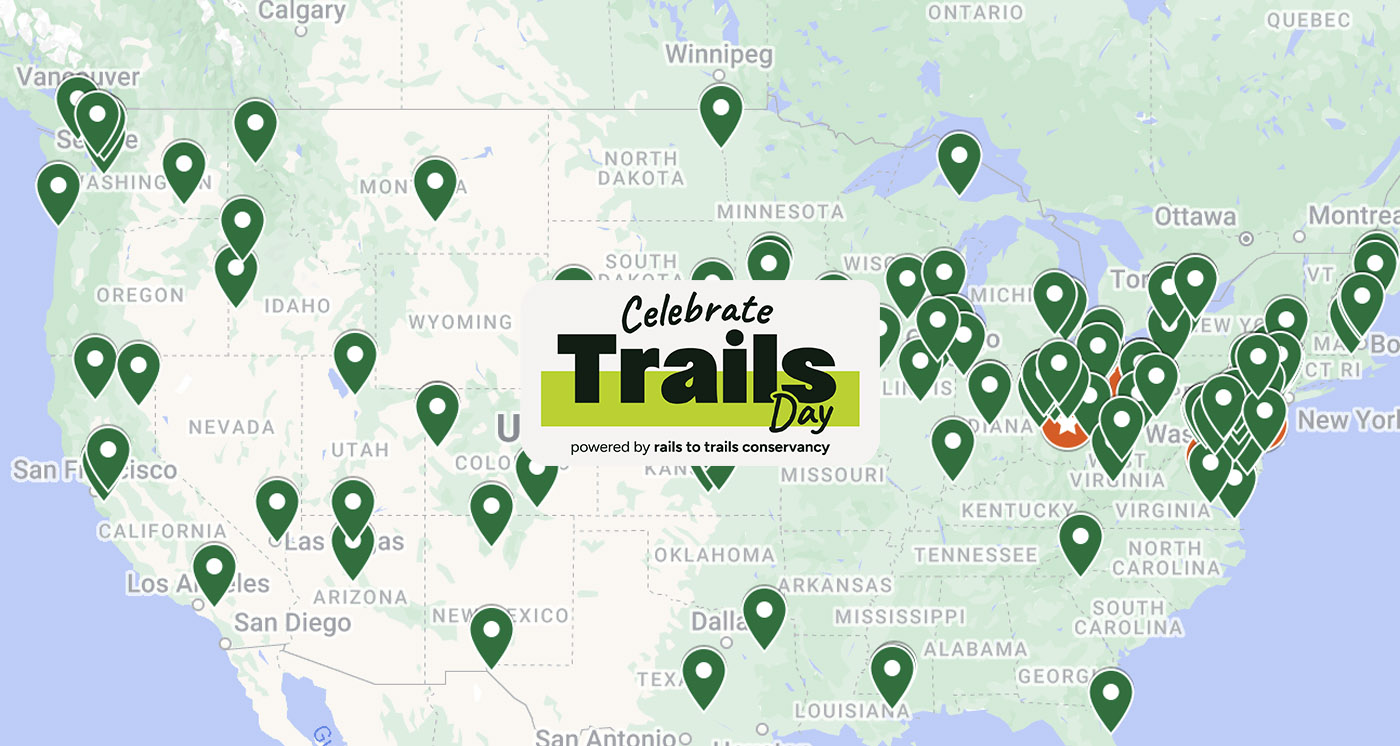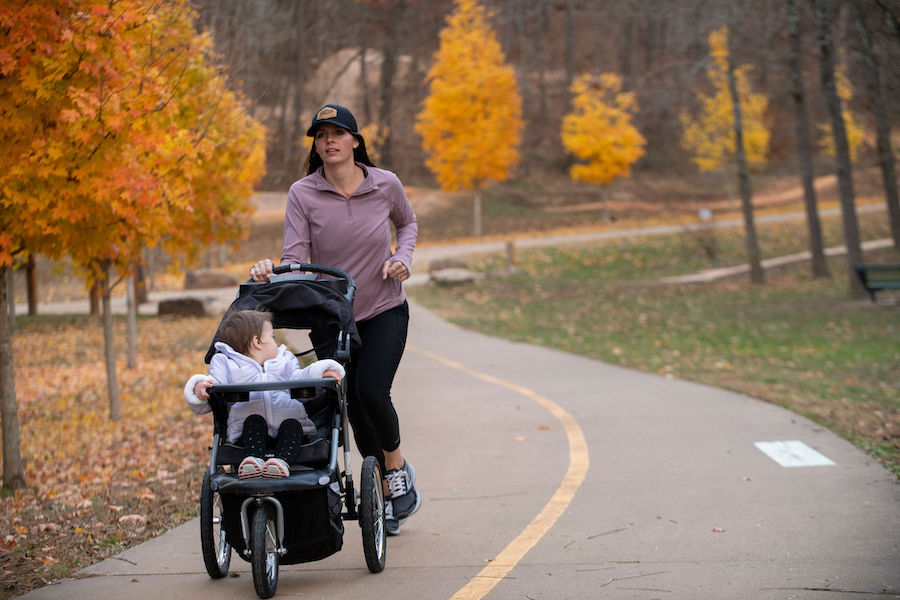Rail-Trail Running for Beginners

If you’ve considered becoming one of the 50 million Americans who participate in some form of running or jogging activity, this article is for you! Running is one of the safest and most popular ways to get fit and stay active. It’s also the simplest activity in many ways—you can just put on your shoes and go, almost no matter where you are.
Rail-trails offer a fantastic option for a beginning running program. They’re pretty and bucolic, which naturally adds to one’s running enjoyment. Since they’re mostly off road, you don’t have to worry about cars (except at intersections, of course) or certain other safety factors related to road running. Another great aspect for the beginner runner is that rail-trails allow you to choose your distance: Rather than committing to a loop, you can park at the trailhead, run as far as you’re comfortable … and then simply turn around!
Here’s some advice for starting out, finding great routes, and maximizing your safety and enjoyment.
How to Get Started

In many ways, the hardest thing about running is getting started. The challenge is as much mental as it is physical. Here are a few tips to make it easier.
Start gradually. If you’re new to running—and you start out by immediately attempting a 3-miler—you’ll likely be miserable. It’s best to start with a run-walk program. Begin with walking slightly faster (we call it ‘fitness walking’) to become accustomed to getting your heart rate up. Then, start doing intervals, say two minutes walking and two minutes running, working your way up to longer sessions. You’ll be surprised at how quickly your body is able to ramp up to more time and longer distances.
Speed is not important. There will be lots of opportunities to improve your speed, if that’s your thing. The most important thing when starting out is to slowly increase the amount of time you can run for, which is also the best way to enjoy the activity and minimize soreness and injury risk.
Set a goal. If things are feeling good, set some goals—for example, running X times per week, or steadily increasing the amount of time or distance. A great initial goal is to be able to run 1 mile without stopping, and then work up to a 5K (3.1 miles). There are many wonderful “couch to 5K” type programs that provide structure to achieving a running goal. A favorite is None to Run, an app and community for beginner runners.
Footwear. It’s best to run with a shoe designed for running. These shoes tend to be lighter than typical sneakers or walking shoes and feature proper support cushioning, which makes the running impact easier on the body. I recommend going to a running-specific or sporting goods store with knowledgeable reps. They’ll actually watch you run to help you select a shoe that’s best for your foot shape, and also for the way you run, such as pronation. Note: If you’re sticking to roads and multiuse paths such as rail-trails, you don’t need a “trail running” shoe, which is designed for more technical terrain.
Pro Tip: Replace the shoes you use to run every 300 to 500 miles.
Listen to your body. When starting out, it’s normal to experiencing some soreness after running, since it’s a new activity and you’re using different muscles. The key is to know your body and not overdo it. If experiencing persistent soreness or some other form of strain, take some rest days or perhaps consult your doctor.
Another factor here to consider is the running surface. Some runners find that paved surfaces can be tough on the body. Rail-trails can be a great option here. You can use TrailLink™—Rails to Trails Conservancy’s national trail-finder website—to find trails featuring non-paved surfaces. TrailLink lists more than 40,000 miles of multiuse trails, with a terrific search function to find options in your local area—or when traveling.

Best Ways to Enjoy Trail Running

OK, so you’ve caught the bug. Now that you know you can do it, it’s equally important to maintain it. The key is to see running as something enjoyable, rather than another obligation or form of drudgery. Here are some ways to help make running a wonderful and joyous part of your life.
Run with others. Lots of running happens alone, and that might be what you’re seeking—an hour away from work, the kids, or other stress and obligations. But it can be fun to run with others as well. It could be a running buddy. Or, connect with a running club or a group run—as these ladies have done on the Pere Marquette Rail Trail in Michigan.
Running clubs and running stores, such as the Fleet Feet chain, host group runs a couple times a week. Don’t be daunted; many of these group runs have options for different levels of speed and distance. Another fun option, when traveling, is to join a running tour. It’s like a walking tour … but running!
Among the best companies that do this is Go! Running Tours, which hosts running tours in 100+ cities worldwide.
Variety is key. One of the biggest reasons runners quit: boredom. Yeah, it gets old doing the same loop in your neighborhood three times a week. Adding some variety is critical to running enjoyment.
Pro Tip: Head to a special spot on a day where you have more time, such as on a weekend. Perhaps it’s a waterfront route, a beautiful park or a serene, wooded trail.

Great Runs, which is a guide to the most interesting and beautiful places to run worldwide—including trails—is another helpful resource. You’ll be surprised at how many hidden gems are near you! The “multi-use” trail feature includes thousands of easier off-road trails, including many wonderful rail-trails for running.
Tunes and casts. When running it’s important to be totally aware of your surroundings. But music—when used safely—can be a great running buddy, and there are tons of running playlists on Spotify and Apple Music. Running also offers a great opportunity to catch up on podcasts or enjoy an audiobook.
Pro Tip: Keep the volume low enough to be able to hear cars, bike bells, etc., and so you’re not impacting others’ enjoyment of trails.

Safety Tips for Trail Running

Reward yourself! Create an incentive for achieving a goal or milestone. Perhaps it’s as a post-run treat, a soak in a tub or some other form of self-care.
Here are some tips to make running as safe and injury free as possible!
Research your route. On trails, it’s best for beginners to make sure that the trail surface is fairly even (no roots or rocks) and not too hilly. Rail-trails—many of which are straight with a low grade—are often the ideal spot for runners. Both Great Runs and TrailLink can provide reviews and helpful information on surfaces, grades, potential impediments and waypoints, such as parking, restrooms and water.
If there’s a road section of your run—for example, getting to a rail-trail or a connector between trail sections, try to make sure the road features a decent sidewalk or wide shoulder. If you have to run on the road, always run opposite to traffic, so cars can see you.
Running in the dark. If your run will be during non-daylight hours, make sure you choose a rail-trail that’s lit (and note that some rail-trails are closed at night or beginning at certain times each evening). If on roads, stick to busier, well-lit streets with sidewalks, or run in quiet residential neighborhoods where the streets are lit. Wearing a reflective vest is always a good extra safety measure.
Be mindful of the weather! On hot days, avoid running when the sun is strongest, or seek a shaded route. Always carry water (whenever you can). Sites such as TrailLink provide important information such as whether the trail is open or wooded and what facilities are located along the way where water is available. For winter running, there are inexpensive gripper type products that can be easily strapped on running shoes to improve traction in slippery conditions. Avoid running when it’s icy.
Final Thoughts

A final, general tip: It’s OK to take a break from running! Perhaps you’re a bit sore, or a bit bored. Add some other type of vigorous activity to maintain your fitness and the good ‘ol endorphin rush, then come back to running after a couple weeks. And, from someone who’s been running an average of three times per week for 35+ years, here’s my running mantra: You’ll [almost] always be glad you did it!
Special thanks to Mark Lowenstein, chief running officer for Great Runs, for contributing this article.

Donate
Everyone deserves access to safe ways to walk, bike, and be active outdoors.
